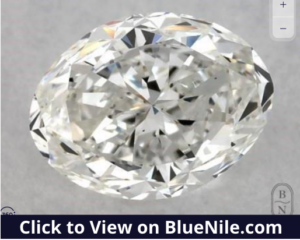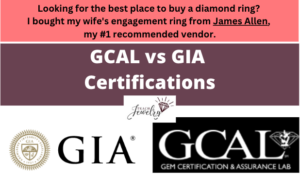
If you’re searching for the perfect diamond, you’ve likely come across diamond grading reports. Vendors promote diamonds as graded by independent third parties to give you confidence in its quality.
Two acronyms you may read next to a diamond are certifications from the Gem Certification & Assurance Lab (GCAL) or the Gemological Institute of America (GIA).
Let’s compare GCAL versus GIA diamond reports, including what you should know about each organization and how their offerings differ.
What are GIA Diamond Reports?
The GIA, founded in 1931, is the most well-regarded organization for assessing diamonds.
Many in the industry consider the GIA to have the most consistent, reliable grading standards.
When I was buying an engagement ring for my wife, I landed on a GIA diamond from James Allen, and I couldn’t be happier with the quality and experience.
Like GCAL, they provide a full set of services for the industry, including education, programs and courses, research, and diamond certificates. The GIA is credited with developing the four Cs, which is used by nearly every retailer to describe a diamond.
They provide reports for a range of gems: natural diamonds, natural colored diamonds, colored stones, and pearls. If you own a stone, but you aren’t sure what it is, they’ll even do the work of identifying its type.
Prospective buyers know them best for their natural diamond grading reports.
If you’re shopping for a diamond online or in-person, you’ll likely find their name next to diamonds as a way to give the buyer confidence in its stated characteristics.
GIA diamonds are examined by expert gemologists, where they first determine if it’s natural or lab-grown. This first step is important because the GIA has different criteria for lab-grown diamonds.
GIA reports feature much of the same information you’ll find in reports from other organizations such as the IGI, HRD or GSI.
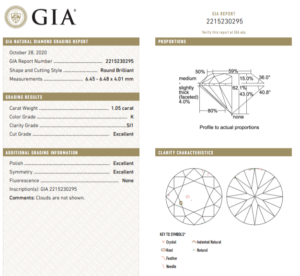
In the first panel, you’ll find the GIA report number to match with the diamond, as well as:
- Shape and cutting style
- The four Cs
- Polish
- Symmetry
- Fluorescence
Similar to GCAL reports, it includes a diagram of the diamond’s proportions.
To verify your diamond has been graded by the GIA, you can look up its serial number. For example, the diamond in the report above has a serial number of “2215230295.”
On the “Report Check” page of the GIA’s website, I entered that number into the search bar.
This report on their website is the same one displayed on the vendors website, so I know its authentic.
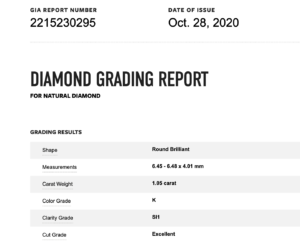
When you’ve decided on a diamond, the number on the report from the vendor, the serial number on its girdle, and the information on the GIA’s website should all match.
What are GCAL Diamond Reports?
GCAL was founded in 2001 by prominent jeweler Donald A. Palmieri. It provides a range of services to the industry, such as educational resources, metal testing, diamond appraisals, and quality assurance testing.
For consumers, they’re most known for providing grading reports for diamonds that ensure the buyer of its value. GCAL not only grades loose diamonds, but also:
- Precious metals
- Colored stones
- Colored diamonds
- Pearls
Its certificates are broken down into three parts. The panel of the left verifies the identity of the diamond.
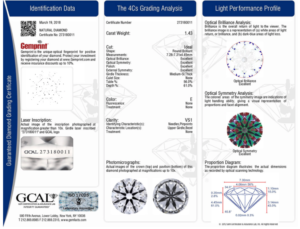
The process of identification involves laser inscription with a serial number. The inscription on the diamond matches the number on the report.
To verify a GCAL report is authentic, you can enter its number on this page of GCAL’s website.
To illustrate, the report number for this round-cut diamond is “332570051.” I entered the number, and GCAL shows this report, which is the same one as the vendor’s website.
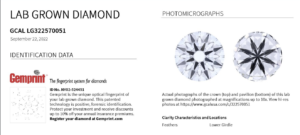
It’s a way to not only confirm the qualities of the diamond but also ensure the vendor is truthful in displaying the certificate.
The middle panel analyzes the diamond’s four Cs: carat, clarity, cut, and color. These characteristics have the strongest impact on the diamond’s price.
The higher grade a diamond receives in each of these categories, the more it’ll cost.
Beyond the grades on the four Cs, GCAL provides the specifics. In the “cut” category, it also includes:
- Shape
- Optical brilliance
- Optical symmetry
- Polish
The third panel in a GCAL report details its light performance.
Brilliance is a priority for many buyers, so GCAL dedicates one-third of its report to this quality. The “Optical Brilliance Analysis” section shows where there’s light return and loss.
“Optical Symmetry Analysis” provides information on the diamond’s proportion and facet alignment. This affects how well the diamond can handle light based on the symmetry of the table’s facets.
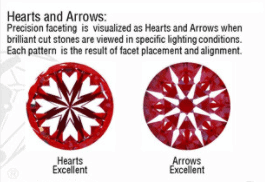
At the bottom of this panel, the “Proportion Diagram” illustrates the actual dimensions.
GCAL offers variations of their standard certificate, including an express grading certificate which is a smaller option compared to the traditional one.
If you’re buying an engagement ring diamond, I recommend basing your decision on the full-length report so you have complete information.
How are GCAL and GIA Reports Different?
1. GIA Isn’t Known for Reports on Lab-Created Diamonds
The GIA didn’t start grading lab-grown diamonds until 2007. Before then, organizations such as GCAL stepped in to fill the gap in the market by providing reports like the one below.
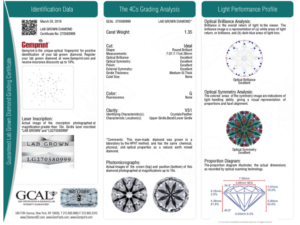
GCAL offers four reports for lab-grown diamonds: a general certificate, a certificate with a hearts and arrows analysis, an express certificate, and a jewelry card.
Its lab-grown diamond reports are more comprehensive than the GIA’s version. GCAL’s include grades for its culet size and optical brilliance.
They also include colored diagrams showing how it handles light based on its proportions and facet alignment.
Both GCAL and GIA lab-grown diamond certificates detail how the diamond was created. The most popular methods are Chemical Vapor Deposition and High Pressure High Treatment.
2. GCAL Provides Extensive Detail on Inclusions
Clarity plots on a GIA report show the type, size, and position of inclusions. It’s found in the middle panel. The plot gives a top and bottom view of the diamond, with corresponding symbols to show the inclusions.
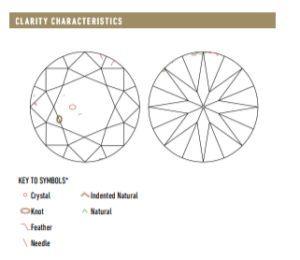
For example, here’s an oval cut diamond.
It has the following inclusions.
- Crystals
- Indented naturals
- Needles
It lets the potential buyer not only know which types of inclusions are present but where they’re positioned on the diamond.
The clarity plot is helpful because there are certain types of inclusions you should avoid, such as large features or cavities near an extremely thin girdle or a sharp corner.
GCAL certifications include the overall clarity grade and types of inclusions while also providing buyers an image of their real diamond.
In the “Identifying Characteristics” section, you’ll see the inclusions. Below that, GCAL lists their location. In this example, needles and pinpoints are located on the upper girdle and bezel.
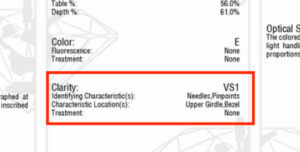
This analysis is incredibly helpful for buyers. You’ll know their size and exact location, which you can use to determine whether it’s the right diamond for you.
3. GCAL Offers Certificates with a Guarantee
GCAL promotes they’re the only gemological laboratory that stands by their grades with a money-back guarantee.
Other grading labs include disclaimers that keep them from liability for errors in judgement. For example, if a grader gave a diamond an E color grade, but it was actually an H, courts have ruled the seller is responsible.
The GIA includes limitations for its reports.
It states their reports are not guarantees, valuations, or appraisals, so it doesn’t provide a warranty. So if the GIA gemologist provides one color or clarity grade, and another institution grades it differently, the GIA isn’t responsible for the discrepancy.
The lack of guarantee from many institutions is additional reason to choose a diamond from one that’s reputable.
4. GCAL Certificates Include an Image of the Diamond
Another difference between GCAL and GIA reports is GCAL includes an actual image of the diamond on its report. At the bottom of the middle panel, there’s an image of its crown (the top) and pavilion (bottom).
I’ve posted an example below.
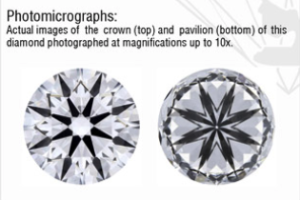
It’s photographed at 10x magnification, so it allows you to see the details of its cut and degree of symmetry in the facets.
GIA reports don’t include a similar image.
Instead, the clarity plot is the same on all reports, and its only purpose is showing inclusions.
While its proportions diagram is helpful for learning measurements like its table depth and percentage, the image is the same outline that appears on all of its reports.
Even though GCAL’s image is an added feature, you shouldn’t buy a diamond unless you’ve seen it in person or online through a high-resolution image.
Though it’s magnified, it doesn’t provide enough information on its own to warrant a decision on whether it’s a diamond worth buying.
But it’s a helpful step in your decision.
5. GIA Reports are More Popular
If you’re browsing for a diamond at the most popular retailers, you’re more likely to find ones certified by the GIA versus GCAL.
The GIA is the preeminent organization for grading diamonds, and many buyers narrow their search to only consider ones with their stamp of approval.
This results in retailers opting to send their diamonds to the GIA more than most other institutions, including GCAL.
For example, two of the most popular online diamond retailers, Blue Nile and James Allen, offer GIA reports with their diamonds.
In fact, Blue Nile’s complete collection is graded by the GIA.
But other retailers also include GCAL certifications. The list includes:
- Helzberg
- Costco
- Robbins Bros
The strength of the GIA’s and GCAL’s list of partners demonstrates their credibility.
How do GCAL and GIA Reports Impact a Diamond’s Price?
The same diamond could sell for a different price depending on whether it’s graded by the GIA or GCAL.
There are two ways a report impacts price. The first is the diamond’s sale price is based on the grades it’s given. For example, let’s assume one diamond is given the following grades:
- Carat: 2.00
- Cut: Very good
- Color: F
- Clarity: VVS2
The same diamond could be graded by another organization as:
- Carat: 2.00
- Cut: Excellent
- Color: F
- Clarity: VVS1
If the seller based the price on the second grade, they could sell it for a higher price. It’s the same diamond, but the lab that gave it a higher grade can cause it to sell for more.
This illustrates why it’s important to have a reliable lab grade a diamond. Stricter grading generally results in a lower price.
The second way a report impacts cost is you’ll often pay a premium for a diamond graded by the GIA compared to other labs.
The GIA has earned a reputation that allows them to charge more for their services, and that cost is passed on to the buyer. In most cases, it costs the vendor $150-$300 for the GIA to provide a report.
Should You Choose a GCAL or GIA Diamond?
GCAL and the GIA are both reputable institutions that verify the qualities of diamonds. You can be confident in the results they provide.
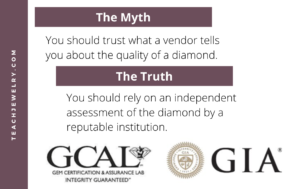
You need assurance the price you pay for a diamond is based on the most accurate assessment. These two organizations solve that problem by providing a comprehensive analysis of a diamond’s traits in a way that’s easy to understand.
That’s why I tell buyers to start their search with organizations like GCAL and the GIA.
They have my confidence because of their demonstrated history of evaluating diamonds.

Jacob Clarke
Jacob Clarke is the founder of TeachJewelry.com.
He earned an Applied Jewelry Professional Diploma from the Gemological Institute of America (GIA) and now brings you essential information about diamonds, settings, and more.
Jacob has consulted with leading jewelry brands, and his work has been cited in Clean Origin, Diamond Nexus and industry publications.
He's also a member of the International Gem Society.
He enjoys discussing jewelry with readers, so contact him with any questions at jacob.clarke@teachjewelry.com.

